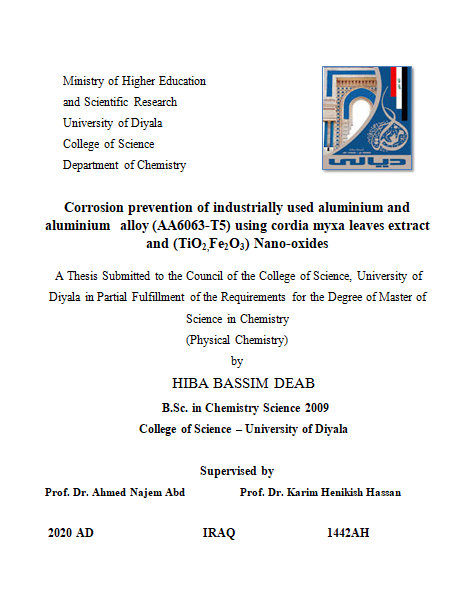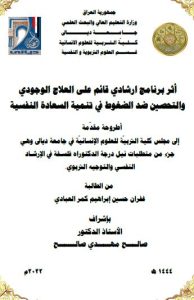(Abstract)
The corrosion rates of aluminum, and aluminum alloy (AA6063-T5) in (1M H3PO4) and (at PH of 4) in the presence and absence of (CML) Cordia myxa leaves extract and nanomaterials inhibitors were. examined at various temperatures (303,313, 323and 333K). Using the method .of weight loss, the plant, material, Cordia myxa leaves (CML) extract at concentration of (2-10 mg/L) for (Fe2O3 and TiO2) nanomaterials, at concentrations (1and 2.5) wt%. The corrosion rate increases, with increase of temperature and decreases with increase the concentrations of the inhibitors. Noted that the highest inhibitor efficiency was (90.95%) for aluminum and (87.60%) for aluminum alloy (AA6063-T5) for (CML) extract and (71.43%) for aluminum and (68.78%) for aluminum alloy (AA6063-T5) for (Fe2O3) nanomaterial. and (67.02%) for aluminum and (60.01%) for aluminum alloy (AA6063-T5) for (TiO2) nanomaterial at a temperature of (333K) and even at the upper concentration ,limit. Three models have been used to describe the corrosion inhibitor adsorption mechanism on the surface, of the metal and it has been found that the inhibition obey the description of the Langmuir, adsorption isotherm in their model of action more than the Freundlich, adsorption isotherm and more even than the Temkin adsorption isotherm, meaning that the materials that inhibit corrosion operate on the surface of the metal ,with monolayer formation according to the adsorption. An equation was used (Arrhenius, Equation) and the transition state equation, (Activation Energy, Ea), Enthalpy of Activation, (∆H°) and Entropy of Activation, (∆S°) values with the presence. and absence of inhibitory compounds. .To determine the active groups in the (CML) extract before immersion in the corrosion solution and after the immersion process, an infrared spectrum (FTIR) technique was used to determine the active groups in the extract, as there was a difference between the results. and the displacement of the FTIR peaks due to the adsorption on the metal surface aggregates .
X ray diffraction(XRD) technique was. used to study coated metal surface after corrosion with the presence and absence of nanomaterials inhibitors (Fe2O3 and TiO2). Atomic Force microscopy (AFM) technique was also to study the metal .surface before were used to calculate and after corrosion in the presence and absence of (CML) extract .
coated metal surface after corrosion in the presence and absence of (Fe2O3 and TiO2) nanomaterials inhibitors. Scanning electron microscopy (SEM) was. also used to study coated the metal surface morphology. after corrosion with the presence and absence of nanomaterials inhibitors (Fe2O3 and TiO2).(XRD .and SEM) show that in presence nanomaterials (Fe2O3 andTiO2) reduced the degree of corrosion . Finally from (AFM) in the presence of (CML) extract (Fe2O3and TiO2) nanomaterials surface became smooth. because of the formation of inhibition film. over metal surface.





